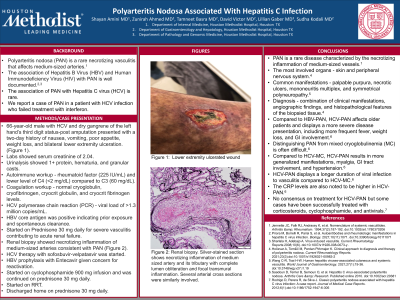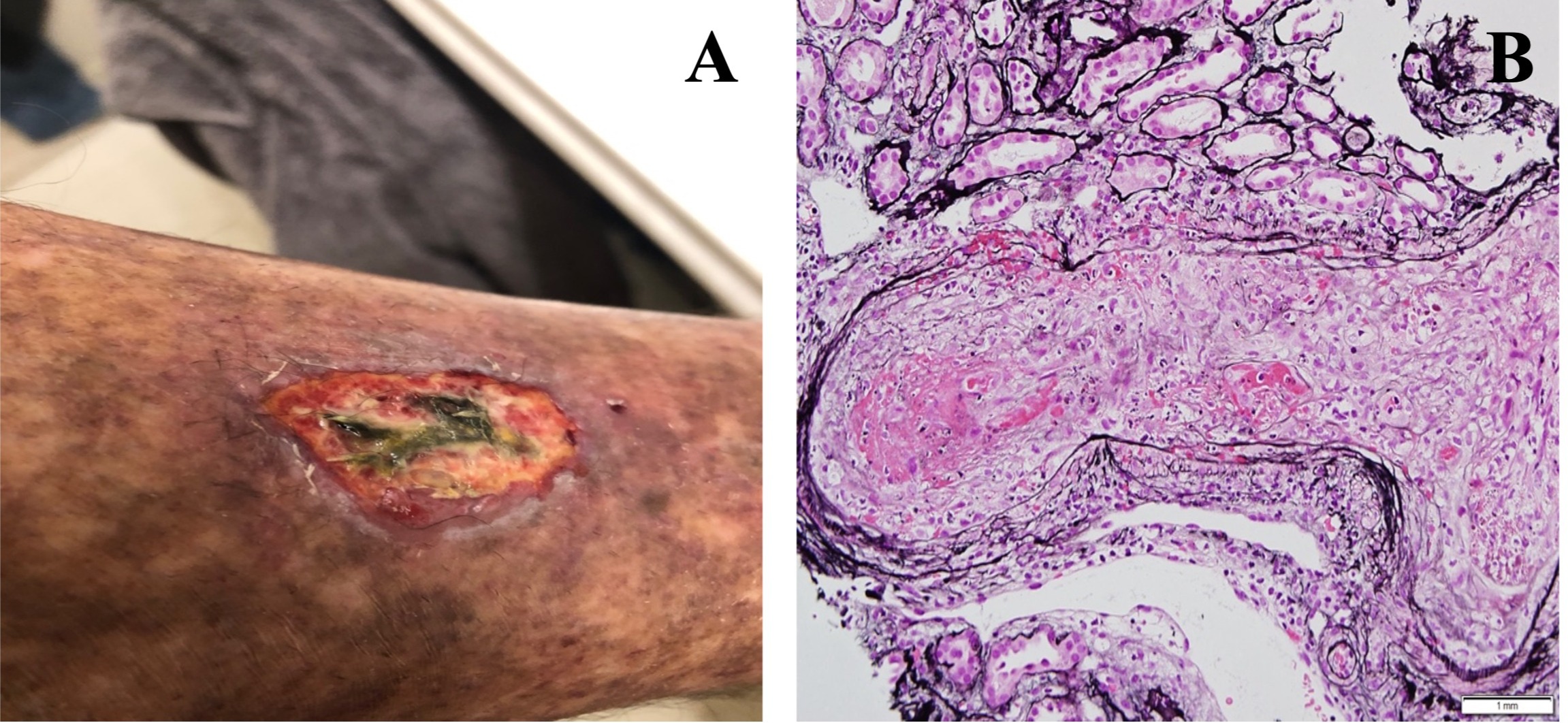Sunday Poster Session
Category: Liver
P1051 - Polyarteritis Nodosa Associated with Hepatitis C Infection
Sunday, October 22, 2023
3:30 PM - 7:00 PM PT
Location: Exhibit Hall

Has Audio
- SA
Shayan Amini, MD
Houston Methodist Hospital
Houston, Texas
Presenting Author(s)
Shayan Amini, MD, Zunirah Ahmed, MD, Tamneet Basra, MD, David W. Victor, MD, Lilian Gaber, MD, Sudha Kodali, MD, MPH
Houston Methodist Hospital, Houston, TX
Introduction: Polyarteritis nodosa (PAN) is a rare necrotizing vasculitis that affects medium-sized arteries. The association of Hepatitis B Virus (HBV) and Human Immunodeficiency Virus (HIV) with PAN is well documented. PAN in patients with Hepatitis C Virus (HCV) infection is rare.
Case Description/Methods: A 66-year-old male with past medical history of HCV (diagnosed 30 years ago) and dry gangrene of left hand’s third digit status post amputation, presented with one-day history of bilious emesis, weight loss, and bilateral lower extremity ulceration without edema (Figure A). Laboratory data showed normal liver function tests and elevated creatinine (2.40). Urinalysis showed +1 protein, hematuria, and granular casts. Renal ultrasound was unremarkable. Autoimmune work-up revealed elevated ANA ( >1:320), CRP (1.84), and RF (225). C3 and C4 levels were low. Coagulation work-up showed normal cryoglobulin, cryofibrinogen, cryocrit globulin, and cryocrit fibrinogen levels. HCV PCR was positive with a viral load of >1.3 million copies/ml. Hepatitis B core antigen was positive with negative surface antigen indicating prior exposure. Renal biopsy was done due to rapidly declining kidney function that showed necrotizing inflammation of medium-sized arteries consistent with PAN (Figure B). Sofosbuvir-Velpatasvir therapy was started for active HCV infection along with Entecavir for HBV prophylaxis. Cyclophosphamide and prednisone were started for PAN. Unfortunately, the patient’s kidney function continued to deteriorate requiring hemodialysis. He was eventually discharged home on Prednisone with outpatient follow up arranged.
Discussion: PAN is a medium-sized vessel vasculitis commonly associated with HBV. Although less common, HCV positivity has been documented in patients with PAN. Compared to HBV-PAN, HCV-PAN displays a more severe disease presentation, including more frequent fever, weight loss, GI involvement, and lower survival rate. HCV-PAN displays fewer cutaneous manifestations and a shorter average period from viral infection to development of vasculitis. There is no consensus on treatment for HCV-PAN but some cases have been successfully treated with corticosteroids, cyclophosphamide, and antivirals. Distinguishing PAN and mixed cryoglobulinemia is often difficult since 40-60% of HCV patients test positive for serum cryoglobulins. Despite its less known association with HCV, PAN should be considered in HCV patients who present with signs and symptoms of vasculitis.

Disclosures:
Shayan Amini, MD, Zunirah Ahmed, MD, Tamneet Basra, MD, David W. Victor, MD, Lilian Gaber, MD, Sudha Kodali, MD, MPH. P1051 - Polyarteritis Nodosa Associated with Hepatitis C Infection, ACG 2023 Annual Scientific Meeting Abstracts. Vancouver, BC, Canada: American College of Gastroenterology.
Houston Methodist Hospital, Houston, TX
Introduction: Polyarteritis nodosa (PAN) is a rare necrotizing vasculitis that affects medium-sized arteries. The association of Hepatitis B Virus (HBV) and Human Immunodeficiency Virus (HIV) with PAN is well documented. PAN in patients with Hepatitis C Virus (HCV) infection is rare.
Case Description/Methods: A 66-year-old male with past medical history of HCV (diagnosed 30 years ago) and dry gangrene of left hand’s third digit status post amputation, presented with one-day history of bilious emesis, weight loss, and bilateral lower extremity ulceration without edema (Figure A). Laboratory data showed normal liver function tests and elevated creatinine (2.40). Urinalysis showed +1 protein, hematuria, and granular casts. Renal ultrasound was unremarkable. Autoimmune work-up revealed elevated ANA ( >1:320), CRP (1.84), and RF (225). C3 and C4 levels were low. Coagulation work-up showed normal cryoglobulin, cryofibrinogen, cryocrit globulin, and cryocrit fibrinogen levels. HCV PCR was positive with a viral load of >1.3 million copies/ml. Hepatitis B core antigen was positive with negative surface antigen indicating prior exposure. Renal biopsy was done due to rapidly declining kidney function that showed necrotizing inflammation of medium-sized arteries consistent with PAN (Figure B). Sofosbuvir-Velpatasvir therapy was started for active HCV infection along with Entecavir for HBV prophylaxis. Cyclophosphamide and prednisone were started for PAN. Unfortunately, the patient’s kidney function continued to deteriorate requiring hemodialysis. He was eventually discharged home on Prednisone with outpatient follow up arranged.
Discussion: PAN is a medium-sized vessel vasculitis commonly associated with HBV. Although less common, HCV positivity has been documented in patients with PAN. Compared to HBV-PAN, HCV-PAN displays a more severe disease presentation, including more frequent fever, weight loss, GI involvement, and lower survival rate. HCV-PAN displays fewer cutaneous manifestations and a shorter average period from viral infection to development of vasculitis. There is no consensus on treatment for HCV-PAN but some cases have been successfully treated with corticosteroids, cyclophosphamide, and antivirals. Distinguishing PAN and mixed cryoglobulinemia is often difficult since 40-60% of HCV patients test positive for serum cryoglobulins. Despite its less known association with HCV, PAN should be considered in HCV patients who present with signs and symptoms of vasculitis.

Figure: Figure A: Lower extremity ulcerated wound, Figure B: Renal biopsy. Silver-stained section shows necrotizing inflammation of medium-sized artery and its tributary with complete lumen obliteration and focal transmural inflammation. Several arterial cross sections were similarly involved.
Disclosures:
Shayan Amini indicated no relevant financial relationships.
Zunirah Ahmed indicated no relevant financial relationships.
Tamneet Basra indicated no relevant financial relationships.
David Victor indicated no relevant financial relationships.
Lilian Gaber indicated no relevant financial relationships.
Sudha Kodali indicated no relevant financial relationships.
Shayan Amini, MD, Zunirah Ahmed, MD, Tamneet Basra, MD, David W. Victor, MD, Lilian Gaber, MD, Sudha Kodali, MD, MPH. P1051 - Polyarteritis Nodosa Associated with Hepatitis C Infection, ACG 2023 Annual Scientific Meeting Abstracts. Vancouver, BC, Canada: American College of Gastroenterology.
